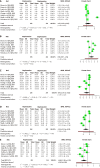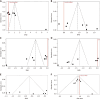Comparative efficacy of hyperbaric bupivacaine vs hyperbaric ropivacaine in spinal anesthesia for cesarean section: A meta-analysis
- PMID: 40548217
- PMCID: PMC11612742
- DOI: 10.5662/wjm.v15.i2.99300
Comparative efficacy of hyperbaric bupivacaine vs hyperbaric ropivacaine in spinal anesthesia for cesarean section: A meta-analysis
Abstract
Background: Intrathecal bupivacaine is the traditional anesthetic drug used in spinal anesthesia for caesarean sections (CSs), but ropivacaine has emerged as a potential alternative. This meta-analysis compares the efficacy and safety of intrathecal hyperbaric bupivacaine vs hyperbaric ropivacaine for cesarean sections.
Aim: To systematically evaluate and compare the efficacy and safety of intrathecal hyperbaric bupivacaine and hyperbaric ropivacaine for spinal anesthesia in CSs.
Methods: A thorough search of electronic databases was carried out to find pertinent randomized controlled trials (RCTs) comparing intrathecal hyperbaric ropivacaine and hyperbaric bupivacaine during CSs. PubMed, Cochrane database, Google Scholar, and Scopus were searched, and papers from January 2000 to January 2024 were deemed eligible and filtered using predetermined inclusion and exclusion criteria. Studies were assessed for methodological quality, and data were extracted for time to adequate anesthesia (sensory and motor blockade), duration of sensory and motor block, hemodynamic changes and side effect profile. The standardized mean difference with 95%CI was used for continuous data. Dichotomous variables were assessed using the Mantel-Haenszel test and the random effect model to compute the odds ratio.
Results: Total 8 RCTs were selected from a pool of 119 search results for meta-analysis. The meta-analysis evaluated pooled effect sizes and assessed heterogeneity among the studies. The primary objective was to compare key outcomes to identify any significant variances in efficacy and safety profiles between two local anesthetics. The analysis revealed that the difference in the onset of sensory blockade between the two local anesthetics was statistically insignificant (P = 0.1586). However, the onset of motor blockade appeared to be faster with bupivacaine (P = 0.03589). Additionally, the regression of sensory and motor blockade occurred earlier in the ropivacaine group. Furthermore, the duration of the first analgesic effect was shorter with a significance level of P < 0.05. Regarding side effects profile, including hypotension, nausea, and shivering, the study did not observe any significant differences between the two groups.
Conclusion: This meta-analysis offers insights into the effectiveness and safety of hyperbaric bupivacaine vs ropivacaine for cesarean sections. Hyperbaric ropivacaine had a comparable safety profile and faster regression of sensory and motor blockade than hyperbaric bupivacaine, perhaps aiding early mobilization of parturient and facilitating mother-child bonding. Choosing ropivacaine may offer benefits beyond efficacy for cesarean section patients and short surgical procedures.
Keywords: Anesthesia; Bupivacaine; Cesarean section; Meta-analysis; Ropivacaine; Spinal.
©The Author(s) 2025. Published by Baishideng Publishing Group Inc. All rights reserved.
Conflict of interest statement
Conflict-of-interest statement: All authors declare no conflict of interest in publishing the manuscript.
Figures





Similar articles
-
Spinal Anesthesia for Cesarean Delivery: Does Ropivacaine Offer Hemodynamic Advantages Over Bupivacaine?Cureus. 2025 May 25;17(5):e84809. doi: 10.7759/cureus.84809. eCollection 2025 May. Cureus. 2025. PMID: 40568250 Free PMC article.
-
Lower Limb Orthopedic Anesthesia: A Randomized Trial Comparing Ropivacaine and Bupivacaine for Sensory-Motor Block and Hemodynamic Stability.Cureus. 2025 May 18;17(5):e84377. doi: 10.7759/cureus.84377. eCollection 2025 May. Cureus. 2025. PMID: 40535370 Free PMC article.
-
Hyperbaric Versus Isobaric Bupivacaine for Spinal Anesthesia: Systematic Review and Meta-analysis for Adult Patients Undergoing Noncesarean Delivery Surgery.Anesth Analg. 2017 Nov;125(5):1627-1637. doi: 10.1213/ANE.0000000000002254. Anesth Analg. 2017. PMID: 28708665
-
Epidural ropivacaine versus bupivacaine for cesarean sections: a system review and meta-analysis.J Matern Fetal Neonatal Med. 2024 Dec;37(1):2313356. doi: 10.1080/14767058.2024.2313356. Epub 2024 Feb 11. J Matern Fetal Neonatal Med. 2024. PMID: 38342577
-
Drugs for preventing postoperative nausea and vomiting in adults after general anaesthesia: a network meta-analysis.Cochrane Database Syst Rev. 2020 Oct 19;10(10):CD012859. doi: 10.1002/14651858.CD012859.pub2. Cochrane Database Syst Rev. 2020. PMID: 33075160 Free PMC article.
Cited by
-
Spinal Anesthesia for Cesarean Delivery: Does Ropivacaine Offer Hemodynamic Advantages Over Bupivacaine?Cureus. 2025 May 25;17(5):e84809. doi: 10.7759/cureus.84809. eCollection 2025 May. Cureus. 2025. PMID: 40568250 Free PMC article.
References
LinkOut - more resources
Full Text Sources

